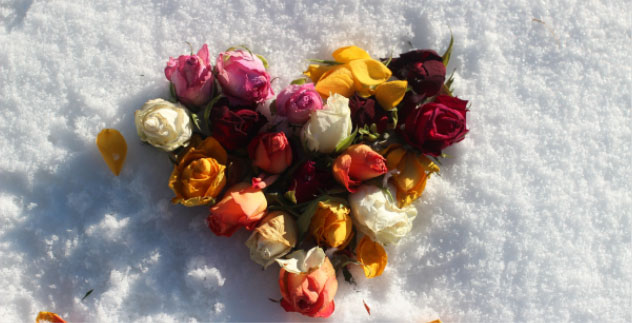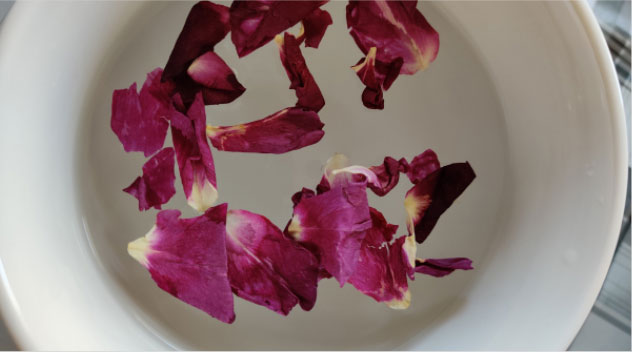Roses at the dining table
The rose has been used as a food since ancient times. In many parts of Asia, such as China, India, Turkey and the Middle East, there is a long tradition of using roses in the kitchen. In Asian cuisines, spices were extracted and distilled from flowers to be used in sweets and pastries and roses were used to accompany meat, fish and beverages. In Central and South America, flowers are also a part of the traditional cuisine and rose petals were used to make pies and many other foods. This region is the home of cocoa so, naturally, it was here that it was discovered what an excellent flavour pairing rose and chocolate are. The edible rose arrived in Europe through the Greeks and Romans. It had been used as a medicine and food in the Roman Empire, long before. For example, wine used to be flavoured with rose petals. Along with the Roman conquerors, the use of roses in cooking spread to Europe.
In the Middle Ages, there was a warmer climate in Europe for a few hundred years and this was favourable for growing flowers. Both in the noble and peasant households there cultivated utility gardens, where flowers were grown and dried for the winter to be used for medicine and food. As the climate cooled in the late Middle Ages, this phenomenon was partly forgotten but the rose food gardening started to bloom again, particularly in England and France, in the 19th century.

Rose food then and now

The edible parts of the rose are the petals and rosehips. Picking a flower for food is a matter of precision. The time of day and the phase of the lunar cycle are believed to affect the taste and nutrient content of the flower. The quality of the product is also affected by humidity and temperature at the time of harvest. In old varieties and varieties bred from the wild rose, the taste and aroma are usually the strongest. For example, the rosehips of Rosa Rugosa and its hybrids are the size of a small apple and they taste delicious.
The rose petals and hips are a true treasure chest of culinary imagination. Queen Elizabeth I of England liked food with flowers, and at her court parties, candied roses were served as decorations for cakes and other delicacies. Refreshing rose water was a perfect addition to the meal and rose was also used as a food colouring.
Nowadays, rosehip jam is a classic in many homes, but jam can also be made from petals. Petals can be used in cakes, syrups, puddings and sauces and they are excellent for seasoning and garnishing meat and fish dishes. Rose petals add colour and flavour to salads, not to mention being an excellent flavour pair for many cheeses.
The 20th century was a time of recession for rose food but as the 21st century approached, roses and other flowers found their way back onto the menus of top chefs and from there, into the consciousnesses of food lovers. So, give your health a positive kick and taste the delicious rose!
Sources: Anne Paalo: Kukkaruokaa, Helsingin Sanomat 18.9.2020
Rose, the queen of flowers
Once upon a time, there was a flower that captivated the world with its scent and beauty. For some, it was the messenger of the angels and a symbol of heavenly love, while for others it was the flower of a more earthly love. In ancient times, the rose garland was a great tribute as it represented gaining the favour of the gods. On the other hand, the rose was also a flower of sensuality, the petals of which were used in orgies to enhance the sexual experience. After nights of festivities, water scented with rose petals served as a hangover medicine.
In the world of fashion, the rose also has a very special place. One of the most famous rose lovers was Madame de Pompadour, who influenced the French court with her dress and hairstyles in the 18th century. Her rose-embroidered costume soon gained a lot of imitators and the classic rose pattern also spread to interior design. Rose-embroidered home furnishings, such as pillows, paintings and rose wallpapers were soon popular and abundant in self-esteemed social circles. Fresh roses were used as decorations in hairstyles and clothes. Over time, rose ornaments were made from a variety of materials such as silk and cotton. Cakes were decorated with marzipan roses and coffee was served in fine china tableware with painted-on roses.



Although the rose had been used around the world for hundreds or even thousands of years, bouquets of fresh roses found their way into homes relatively recently. They became common as an interior centrepece in the 16th and 17th centuries, when vases or jugs made of china began to be used. Floral arrangements, on the other hand, first became common in France in the early 19th century. Today, a rose bouquet is for most people a purely decorative element that reflects the user‘s own colour preference, but a hundred years ago, a rose bouquet served as a communicator of “selam”, and the language of flowers spread to Europe from the harem of the Turkish sultan. Flowers could express admiration, attract attention, show appreciation and serve as a means of congratulation.
Communicator of feelings
“Whenever roses start to bloom, one falls in love with them again.” The stories of Boccaccio‘s Decamarone speak of lovely rose gardens and their smells and refreshing shade. The creation and care of rose gardens and the breeding of new rose varieties are their own form of art. There is an annual contest for the best rose and the famous rose gardens from Japan to Ecuador and England are popular tourist attractions. Ecuador is currently the world’s largest producer of roses as the Andean climate is ideal for rose production.
The scent of a rose is diverse. It contains four hundred volatile ingredients but due to the aroma, only two species are cultivated, namely Rosa centifoglia or manor rose, and Rosa damascena or damask rose. The rose scent contains moss and moist soil, spices and hardwood, musk and powder. One of the most traditional uses of the rose is in perfumes. However, perfumes built solely on the rose have given way to perfume blends over time, according to the latest fashion.
How to preserve the beauty of a rose?
The traditional home method is to dry the bouquet of flowers upside down in a warm, dry and dim, sheltered place. In the 16th century, during the reign of Queen Elizabeth, roses in England were dried by burying them in clean, fine sea sand, which was kept warm until all the moisture had evaporated from the flowers. Today, silica gel granules are used for the same purpose, allowing the colour to be well preserved. Another method is treatment with a water-glycerin mixture through which the liquid naturally contained in the rose is replaced. Freeze drying is particularly suitable for edible roses and flowers used for garnishing, as it retains both nutrients and colour well.
The rose has its place at the tables of culinarists and aestheticists and will certainly continue to serve as a communicator of the feelings of writers and musicians. It governs gently but decisively. Mysterious and powerful, its scent reminds us of the world of the past and brings happiness to every moment. After all, it is the queen of flowers.

Health benefits of the rose

Our ancestors clearly knew the health effects of the rose as it has been used extensively for medical purposes for centuries. Many ailments were treated with remedies containting rose in different forms such as creams, cosmetics, waters and oils for skincare and medicine for headaches, depression and dizziness. Rose petals cooked in white wine served as a liniment for wounds during Napoleon’s time in France. Rose sugar or rose honey was considered a medicine believed to cure all (or most) illnesses. Rose honey is also a happiness mood food, so if a patient‘s ailment did not improve, at least they were in a good mood! The rose is believed to increase vitality. No wonder, because Damascus Rose, for example, containsn early 400 ingredients.
It is well-known today that the rose is an excellent antioxidant and source of vitamin C. Rosehips contain vitamin E, potassium, magnesium and iron. Rose petals and leaves are rich in anthocyanins and phenolic compounds. Anthocyanins are water-soluble, natural pigments belonging to flavonoids that are found in red-blue fruits and vegetables. They have the ability to defend the body against free radicals that are harmful to health and have been shown in several studies to reduce the risk of cardiovascular disease, obesity, cancer, diabetes and other chronic diseases. Phenol compounds are plant derived metabolites that have been shown to have positive health effects. They are rich in antioxidants, and have anticarcinogenic, antimutagenic, antibacterial and antiallergic properties.
Rose and medicine
Studies show that eating food containing anthocyanin reduces the risk of cardiovascular disease and cancer. In Tibet, rose tea is used for cleansing during fasting and the Chinese have a centuries-long tradition of drinking rose tea as a beauty treatment.
Rose water and extracts are widely used in natural medicine, but in traditional western medicine, their use is still limited. There are relatively few scientific studies on the medicinal properties of roses but research to date suggests that they have enormous potential for the pharmaceutical and cosmetics industries.
To your good health!
Sources: Anne Paalo: Kukkaruokaa, Antocyanins – from Plant to health, Rose leaves – a Potential Nutraceutical

Rosa Rugosa Hybrid

The Rosa Rugosa Hybrid is a multiplied rose developed for garden use from the Arctic wild rose, the Rosa Rugosa variety. As it has wild ancestors, the plant is very hardy and healthy. It withstands wind, thunder and frost and has modest soil requirements. In Finnish growing conditions, the Rosa Rugosa Hybrid blooms from June to September.
Unlike its wild cousin Rosa Rugosa, which has gained a bad reputation for invasive spreading, the hybrid variety does not spread on its own. It is well suited for bordering garden beds and makes a beautiful rose fence. However, Rosa Rugosa Hybrid‘s width and height are such that it isnt really suitable for a very small garden.
This rose plant produces a large flower with a charming scent. The petals and rosehips are edible. The taste is sophisticated and bitter, which is a telltale sign that this arctic variety is full of nutrients.


Numerous sub-varieties have been bred from the Rosa Rugosa Hybrid, of which, for example, the beautiful aniline red Rugosa Rose Hansa is used for garnishing and as a raw material for food. At Finnish Plant, rose varieties have been developed with both taste and winter characteristics in mind. The delicious Rosa Rugosa Kotaja draws its strength from the Finnish midnight sun and yields a plentiful harvest. It is a great example of the versatility of this plant.
Sources: Gardening Advice, Arnoldia Arboretum Harvard
